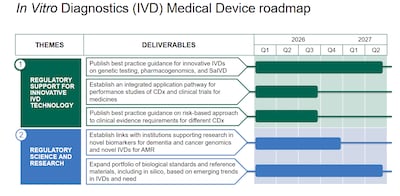As 2025 turns to 2026, Swiss medtechs are anxiously looking to the future on three major fronts, according to Daniel Delfosse, head of regulation and innovation at the national industry association, Swiss Medtech.
MedTech Europe’s Petra Zoellner discusses industry's response to EU regulatory proposals aimed at improving notified body operations, transparency, and cost predictability, ultimately fostering innovation in medical technology.
Joint Singapore-UK plan underlines direction of travel for MHRA after its embracing of international reliance (IR). Australia’s TGA has also broken new ground by recognizing the UKCA mark.
Industry associations support the commission’s MDR/IVDR revision simplification objective and aim to increase Europe’s competitiveness, but MedTech Europe also sees further room for improvement.
The just published proposed targeted revision of the Medical Device and IVD Regulations is a radical rethink of how the EU should regulate medical devices. The document is aimed at supporting industry and patients alike.
Roadmap version 1.0 is a living document, not a legislative instrument, that will be updated and tweaked for timings as necessary.
New document sets out a structured framework to help breakthrough medical devices tackling serious health needs navigate EU regulation with greater clarity, collaboration and predictability.
Just ahead of the European Commission publishing its proposed revisions of the Medical Device and IVD Regulations, it has released an equally important document on the future of notified body operations in the bloc.
A new face seconded to the European Commission's medtech unit and changes to several EU rules impacting medtech
Aerogen, which is Ireland’s largest native medical technology firm, is in clinical trials for Aerofact, a nebulizer aimed at aiding premature infants' breathing. The technology promises easier administration of surfactant, with potential commercial rollout projected in three to four years, if succes
Sponsors of higher risk device and diagnostic investigations are being invited to participate in a pilot that aims to reduce regulatory burden.
Start-up medtech firms in the west of Ireland can benefit from incubator programs at two of the region’s universities, which support innovators across the medical device and digital health industries from concept to multi-employee businesses.
Digital technology and AI have pushed healthcare delivery to a transformational turning point, but market access, budget constraints and scaling adoption of innovation remain the eternal challenges for healthtech manufacturers.
The MHRA’s premarket statutory instrument for Great Britain should to be laid before UK parliament in Q2 and be in force by year end, in an ideal world. There are concerns that the new statutory instrument must align with imminent EU MDR changes.
Pragmatic solutions are called for to ensure that German medical device manufacturing and innovation remain competitive in global terms, federal health minister Nina Warken told a hearing of medtech industry leaders.
Simultaneous revisions of the EU’s AI, data and medtech rules offer opportunities for simplification and alignment but also risk confusion and competing priorities. With political tensions in the background, does all this portend further unwanted compromises or delays for medtech?
After years of delays - and even skepticism in Rome last month when officials hinted at its imminent debut - the long-awaited EUDAMED medical device database release has finally been confirmed
The European Commission’s Digital Omnibus Package promises to simplify EU complex digital compliance processes, but is it taking the EU in the right direction in its simplification efforts?
The European Commission seems to have heeded many of the medtech industry’s points regarding challenges with the implementation of the AI Act within the Digital Omnibus. But the usual EU hurdles must be crossed before the sector will know if these proposals will make it into law.
Medtech companies should not look at the current period as a regulatory hiatus, but as an opportunity to avoid a crisis two to three years down the line.




















